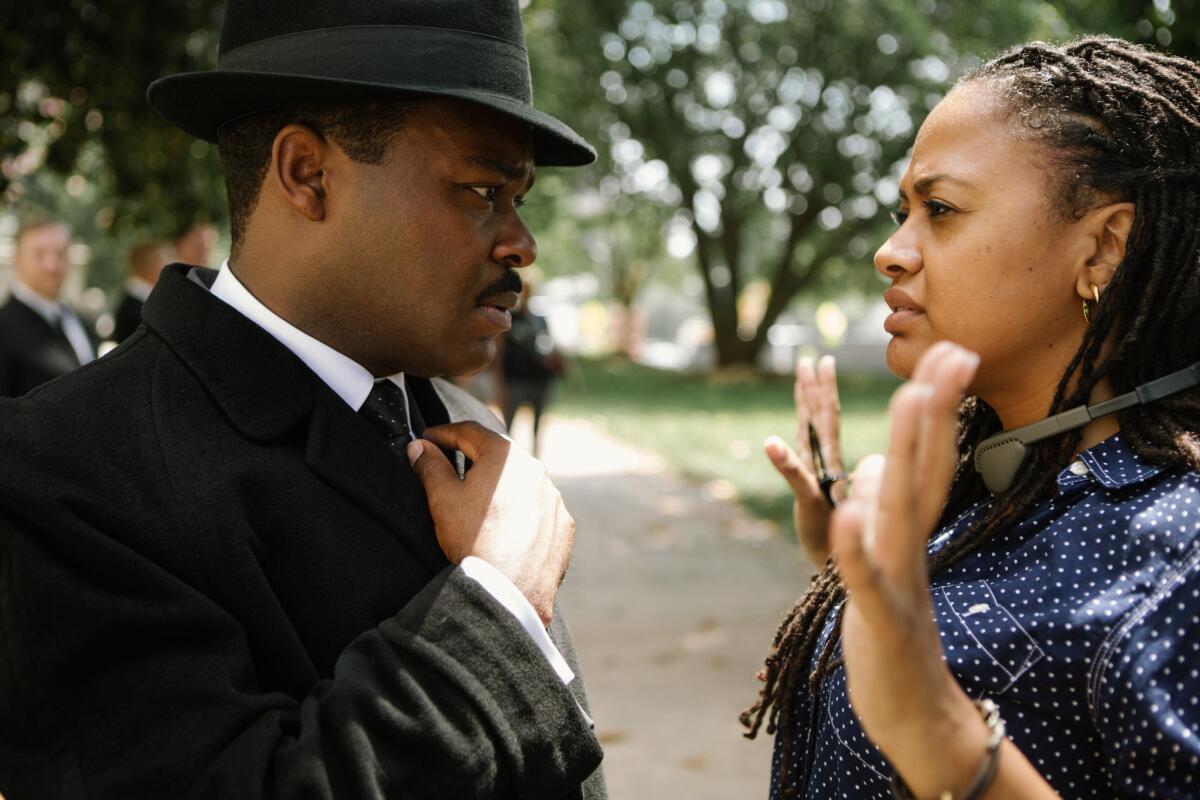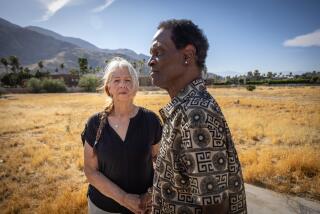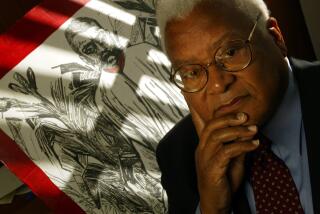In Selma, Alabama, a movie makes a town remember

- Share via
Reporting from Selma, Ala. — Vera Booker recalls Bloody Sunday like it happened this week. A 29-year-old-nurse in 1965, Booker was relishing some rare time off that fraught March weekend. Then the call came.
Black protesters had been beaten up by a white police force at Selma’s Edmund Pettus Bridge, she was told; could she hurry in to her job at Good Samaritan Hospital to help treat the victims?
“They were everywhere — bleeding and hurt,” said Booker of the scene that greeted her. “But no children. It was all adults. It was as if the adults had made sure all the children would be away from the worst of it.”
On Friday night, Booker eagerly sat in the front row of a movie theater here so she could relive that period 50 years ago — first torturous, then triumphant — captured by Ava DuVernay’s Golden Globe nominee “Selma.” Booker, who like many of Friday’s attendees is black, was bracketed by her grown daughter and her husband, a minister who went on to participate in the Rev. Martin Luther King Jr.’s historic march to Montgomery two weeks after Bloody Sunday.
Paramount on Friday opened “Selma” nationwide after a successful arthouse run, beaming into multiplexes around the U.S. a grand and tense story that until now has mostly been told via textbooks and newsreel footage. Yet the screening of “Selma” in Selma offers a reminder that even the most resonant fact-based tale vibrates in a different way in the place where those facts occurred, where a film is less history than memory.
The choice of venue to open the film here was a single-screen theater known as the Walton. It was closed a year ago but reopened by the city to celebrate DuVernay’s film. Beginning Friday and continuing through the end of the month, officials said, “Selma” will screen at the location, for free, multiple times each weekend.
The Walton lies just around the corner from the Edmund Pettus Bridge, which, as it humps over the Alabama River that delineates the edge of downtown, serves as both border marker and icon. Its appearance hasn’t changed much over the years, amplifying the art-meets-reality effect. If the events on screen didn’t seem realistic enough already, a few steps out into the cold Alabama night would ensure they did.
“You’re going to see some things that will wake you up,” the city’s black mayor, George Evans, told filmgoers as he took the stage to introduce one of the “Selma” showings Friday evening.
The movie had been a hot-button topic here all week. To some, it prompted buzzy anticipation, providing a chance to see their hometown of 20,000 in full Hollywood relief. But in stores and restaurants around this scruffy city 40 miles west of the state capital, there was also skepticism.
As he stood behind the counter of the drugstore where he worked, 42-year-old Charles Craig, who is black, said, “I just worry it will open old wounds.”
Several retired white city powerbrokers who were adults living in Selma in 1965 were decidedly not ready to embrace the film. “I lived it. I don’t need to see a movie about it,” said one, declining to be identified as he hurried away from a downtown restaurant Friday morning.
Others feared for the film’s accuracy, especially since the movie only shot in Selma for a week. (It was mainly filmed in and around Atlanta.) Discussions of historical correctness that have permeated government and academic circles in recent weeks, especially about the movie’s portrayal of Lyndon Johnson, took a backseat to more nitty-gritty questions about locations and the particulars of the march.
“I understand why folks would ask questions. But I keep reminding them, ‘It’s not a documentary,’” Evans, whose brother participated in the march, said in an interview in his office earlier in the week. “Look at [the assassination of] J.F.K. — there is a lot of documentary footage about that and people still can’t agree on what happened.”
These debates didn’t dampen the enthusiasm for many. Lines stretched around the block outside the theater beginning Wednesday as residents hoped to score one of the coveted free tickets. A mixture of young and old people packed three screenings Friday, with the last one, at 9:45 pm, bringing out mainly those who were not alive when the film’s events occurred.
Marcus Smiley, 38, decked out head to shoe in Crimson Tide gear, had come out with his cousin. He had grown up hearing the stories from relatives, including an uncle who participated in the march. “It’s just exciting to be able to relive it because I wasn’t around when it happened and it’s our history — it’s everybody’s history, but it’s especially our history here in Selma.”
The audience brought a kind of insider sophistication to the proceedings. Even as they watched, with grave expressions, as friends and family members were brutally beaten on the bridge, they also laughed knowingly. A quip of “Can you swim?” — as King and his deputies made their way across the high part of the bridge en route to where Sheriff Jim Clark and his menacing officers waited — garnered an extra-loud laugh, evoking a watery plunge some residents fear or joked about.
And a scene late in the film that has Johnson putting former Alabama Gov. George Wallace in his place also garnered an especially big response.
A number of viewers had come out for different reasons — to see a movie they had taken part in as extras.
Bo Spencer, a white Selma resident, was cast as a police officer wielding a (plastic) billy club, one of the “Sheriff Posse Men,” as the script called them. He said playing the despicable character did not concern him; it was, he said, “a lot of fun.”
When Anne and Stephanie Reynolds, a mother-and-daughter pair from Montgomery, who are white, saw their casting application accepted for a role along the lines of “race instigators,” though, they said they politely requested a change. They were made marchers instead.
David Lee Holland, a jewelry designer who grew up in Selma but has since moved to New York, returned last summer to be an extra. “It wasn’t that hard to get it. They really needed Caucasians. I was a priest. Which if you know me, is pretty funny. “
Evans, the mayor, got in on the act too. During the interview he took out his phone and punched up a still from the film — which, if viewed at just the right angle by an onlooker with superior vision, indeed reveals him standing in a hat behind David Oyelowo’s Martin Luther King Jr. in a march scene.
For all the excitement in the room over the film’s fundamental optimism, it was hard to ignore the local fault lines the screenings expose. The theater’s makeup tilted overwhelmingly black, even by the standards of a city where African Americans make up 80% of the population.
Some also wondered if another of the film’s messages would get lost.
A 25-year-old with a mischievous glint in his eye, Sherman Tate, who is black, stood outside the theater before one screening and said, “I don’t get it. People stand in line two hours to wait for a ticket but they won’t stand in line for much less than that to vote,” he said. “And the right to vote is what brought this movie into the world to begin with!”
Inside the theater, older residents echoed Tate’s sentiments and said what they witnessed in 1965 made them unable to ever take those rights for granted. A few weeks before Bloody Sunday, Booker, the nurse, had treated the young unarmed activist Jimmie Lee Jackson after he was shot by an Alabama state trooper. Booker was initially convinced Jackson would be fine. But he would die a week later, in a tragedy that helped kickstart the Selma-to-Montgomery march.
Booker also treated Annie Lee Cooper, the voting rights activist played by Oprah Winfrey in the movie, and a friend of Booker’s.
“I said ‘Annie Lee, what are you doing here?’ ” Booker said she first asked her pal when Cooper showed up at the hospital. Cooper, it turned out, had been brought in because of injuries she suffered in retaliation for punching Sheriff Clark.
Cooper died in 2010 at the age of 100. One of her contemporaries, Frances Felles, 94, was still carrying the mantle in Selma this weekend.
“I think the line to get movie tickets was longer than the line to vote before 1965. And the line to vote was long,” said Felles, a former teacher with a wry sense of humor, as she sat with a Bible study group near downtown Friday morning. “So I’ll try again next week.”
Felles had lived through much of what the movie depicts — forced to wait at the backdoor of an empty restaurant hours for food, told repeatedly by county registrars they’d “get back to” her on a voting application. (Incidentally, Felles also has a story of seeing a woman, a fellow teacher at her school, strike Jim Clark; apparently this was a popular impulse.)
Felles’ desire to see the movie was matched among her generation by Annie Williams, also a retired teacher. Williams will turn 99 in a few weeks.
“I didn’t wait outside for a ticket,” Williams said. “She did,” laughing and gesturing at her daughter, Patricia, as the two walked back to their car after a screening. “But I wasn’t going to miss it. I’d waited long enough.”
Twitter: @ZeitchikLAT
More to Read
Only good movies
Get the Indie Focus newsletter, Mark Olsen's weekly guide to the world of cinema.
You may occasionally receive promotional content from the Los Angeles Times.











